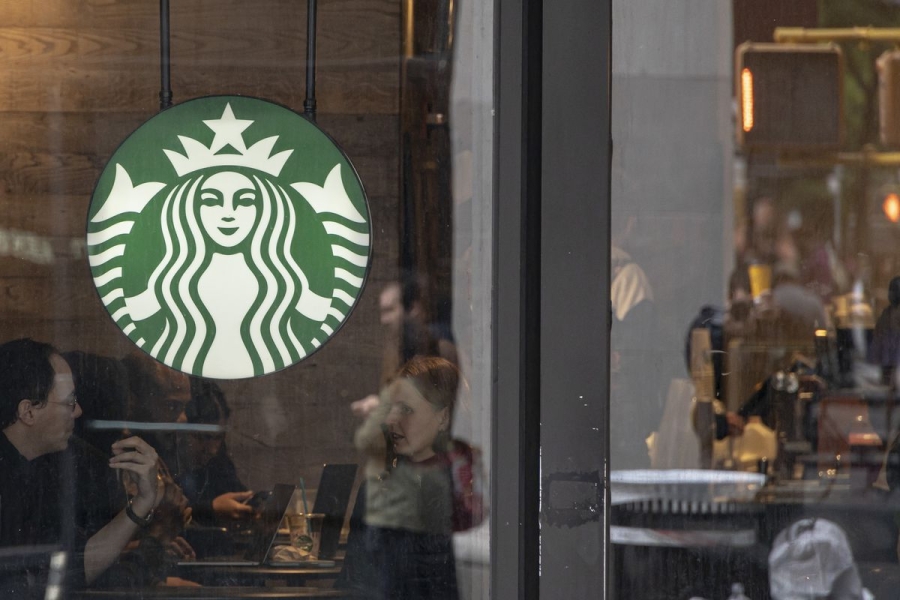Starbucks’s messy December, explained.

Emily Stewart covers business and economics for Vox and writes the newsletter The Big Squeeze, examining the ways ordinary people are being squeezed under capitalism. Before joining Vox, she worked for TheStreet.
Starbucks’s value is down billions of dollars. People online are calling for a boycott of Starbucks. The extent to which these two things are related, if they are at all, is not clear.
One thing is true here: The Seattle-based coffee company is not having a bang-up time heading into the end of the year. Its share price has seen a sharp decline since mid-November, falling by about 9 percent, meaning a decline of some $11 billion in its market cap.
“Starbucks’s stock is experiencing a historic losing streak, influenced by a confluence of factors,” said Siye Desta, equity analyst at CFRA Research, in an email.
Data collected by third parties suggests its foot traffic and sales may be falling short of Wall Street expectations. It’s not necessarily that sales aren’t growing, it’s that they’re not growing as much as investors thought.
Starbucks has seen negative headlines over how it’s handling relations with workers attempting to unionize, many of whom walked off the job in November on its annual Red Cup Day, when it gives out free reusable seasonal cups. In addition, it has found itself caught in the crosshairs of the Israel-Hamas war after a pro-Palestine tweet from the union that prompted calls for a boycott on the right and on the left, though analysts say it’s hard to know the impact these calls are having on the actual business or its stock price.
“I don’t think it’s the protests that are driving this,” said Sara Senatore, senior research analyst at Bank of America. The timeline on foot traffic declines doesn’t really line up with the boycotts, she said. Plus, Starbucks is no stranger to controversy. “This is not the first time that we’ve seen this kind of activity, and so it’s hard, in my view, to conclude that’s the reason that traffic has been so slow.”
Nick Setyan, an equity research analyst at Wedbush, echoed the point. “The boycotts … could be making a little bit of a difference on the margin, a very small impact. I don’t see that having a lasting impact,” he said.
The explanation of what’s happening with Starbucks is actually kind of boring
I will make a quick disclaimer here, which is that nobody ever entirely knows why the stock market does what it does. There’s not some group chat for all the Starbucks investors where everyone talks about the game plan of when to buy or sell. The general rule is that share prices are based on expectations of future earnings, and those expectations can change for a multitude of reasons.
The long and short of what’s happening with Starbucks right now is that investors believe things aren’t going as well as they thought they would. The company had a strong quarter in the July-September period. Same-store sales in the United States were up by 8 percent over the prior year, and it saw an increase in store traffic and average ticket sizes. It got a sales boost on its beloved Pumpkin Spice Latte and other seasonal specialties for the late summer and early fall.
In the following months, in this October-December quarter, some data suggests Starbucks isn’t doing as well, or at least not as well as expected. It appears its deals and specials just aren’t hitting as well as anticipated.
“During the last month or so, foot traffic hasn’t been all that great, and given the high expectations Starbucks went into the quarter with, we’re seeing a little bit of a slowdown versus those high expectations,” Setyan said. “Last quarter, they had some very successful seasonal and limited-time offers, and currently, we’re not seeing the same kind of traction with the current seasonal and limited-time offers.”
Starbucks’s Red Cup Day, held November 16, saw just a 32 percent boost in foot traffic, compared to 81 percent in 2022. According to data provided to Vox by Memo, a media tracking and insights company, readership on news about Starbucks related to Red Cup Day was much higher in 2022 than it was in 2023. Workers walked off the job in both years, and readership about that news declined, too, though to a lesser extent.
“Last year’s success with Red Cup Day was likely partially driven by increased awareness around it as an event — as indicated by the public’s higher engagement with news about the promotion,” said Allison Horton, head of insights at Memo. “We do not see news readership data indicating that this year’s downturn is closely correlated to worker walkouts or boycotts, but rather due to lower consumer awareness and interest in general.”
Starbucks has raised its prices in recent years in response to inflation and the rising cost of labor. Some have argued that Starbucks’s value proposition is a driver of the slowdown, Senatore said, though it’s not a position she agrees with, as Starbucks has taken prices up less than competitors. Still, if consumers — who largely haven’t pulled back on spending despite high inflation — start to finally hold on to their wallets a little tighter, that could be having an impact on the coffee company. Some consumers may view a Starbucks coffee as a “luxury” item they can forgo, especially if they are looking to cut non-essential items. There’s a reason “skip your morning Starbucks to save money” is a bit of a financial advice trope. However, many people see it as an essential part of their daily routine.
In its early November earnings call, Starbucks didn’t indicate a slowdown had been a problem. “Customer demand for us remains strong. We’re not really seeing any change in the sentiment in our customer base at this time,” Starbucks CEO Laxman Narasimhan said. The issue may not yet have been on the company’s radar. Keep in mind too that third-party data on traffic and sales is not always completely reliable, and a clearer picture won’t come until its next earnings release in February 2024.
Starbucks has anticipated growth could moderate over the next year, though that’s not really what’s spooking investors now. It really is they thought same-store growth was going to be something like 6 percent up from last year and it’s not.
To be sure, this isn’t all about the United States, it’s also about China, which is a major chunk of Starbucks’s business. Any concerns about the Chinese economy, of which there are many, are a negative for Starbucks, too. “The question of China is always in the back of investors’ minds,” Senatore said.
The Starbucks boycott stuff is important (and confusing), but it’s not clear it’s that big of a deal, financially speaking
If you are on social media platforms like TikTok, Instagram, or Twitter, you may have come across the recent hullabaloo over calls to boycott Starbucks in relation to the Israel-Hamas war. Both Israel supporters and Palestine supporters have called for consumers to spurn Starbucks over the last couple of months. Bear with me while I try to map this one out.
Soon after Hamas launched its deadly terrorist attack on Israel on October 7, Starbucks Workers United, which represents Starbucks workers pushing to unionize, tweeted out, “Solidarity with Palestine!” above an image of a Hamas bulldozer tearing down a fence along the Gaza Strip. The tweet was quickly deleted, and the union has distanced itself from the message, which it says wasn’t authorized by it or its workers.
Starbucks and the workers union have since sued each other over the matter. Starbucks doesn’t want Starbucks Workers United using its copyright and trademark, and it says the union’s actions have led to complaints because people mistakenly tied the tweet, which it says many people interpreted as support for the October 7 violence, to the company. The union sued back, claiming defamation and saying it’s been using the name Starbucks Workers United since 2021. Both parties say they’re concerned for workers’ safety.
The kerfuffle has caused a sort of boycott-palooza. Some Republican lawmakers, including Sen. Rick Scott of Florida, called for a Starbucks boycott over its workers’ position as represented by the union tweet. Jewish organizations called for a boycott as well. Starbucks and its former CEO Howard Schulz reached out to the Orthodox Jewish Chamber of Commerce to try to reassure them. The OJCC said that Starbucks gave the organization a list of unionized stores for them to boycott. Starbucks has denied the claim, which the union has picked up on.
Palestine supporters are calling for a boycott of Starbucks over its reaction to the union tweet and a contention that the company supports Israel. Pro-Palestine protesters have also gathered outside of some Starbucks stores. Starbucks has said that neither it nor Schulz provide financial support to the Israeli government or army.
It’s a Bud Light-light situation: People are upset about perceived slights by the corporation, but they’re mad in competing directions, and they’re not entirely clear on the facts. Starbucks’s handling of the situation, arguably, hasn’t been great, either. It’s also unclear whether people are changing their behavior and seriously boycotting.
Some people on social media are claiming victory, given Starbucks’s recent Wall Street woes, and saying the pro-Palestine boycotts, specifically, are responsible. There’s just no evidence that’s the case.
The Memo data shows that rather than indicating an engaged boycott, people aren’t paying attention to what’s going on. Analysts acknowledge that boycott calls are happening online, but they say it’s generally tough to tell if they’re making a real difference in sales or investor sentiment. Starbucks has had its fair share of public upheavals over the years after all — over guns, over bathrooms, over red cups, over its approach to union efforts — that it’s made it through just fine before.
“Starbucks has seen various types of boycotts for various reasons, everything from their LGBTQ stance to their gun stance,” Setyan said.
McDonald’s, which has also been a focus of boycotts over the Israel-Hamas war, has seen its share price rise over the past month.
Starbucks vs. the union continues
Much like it’s not clear boycott calls are doing much to Starbucks’s share price, it’s hard to say whether its union push is making much of a dent, either. Union organizing, though, is undoubtedly having an impact on the company.
Starbucks workers first voted to unionize at a store in Buffalo in late 2021. Since then, the company has been engaged in an often contentious push and pull with many of its workers. On December 13, Starbucks released a labor report to shareholders — which shareholders requested in March — on its approach to workers’ rights. The report found that unionization efforts took Starbucks by surprise and said Starbucks needs to better communicate and train employees around the issue.
Even though a relatively small fraction of Starbucks stores have voted to unionize — 382 of over 9,000 in the US — their efforts have prompted changes at the company overall.
In 2022, Starbucks introduced a reinvention plan that aims to, in part, improve pay, benefits, and the overall experience for workers, which it calls partners. (It has a 2023 reinvention strategy, too — Starbucks does a lot of reinventing.) It has expanded digital tipping and implemented a number of other benefits and improvements, many of which it has not offered to unionized stores. It’s making it easier for overwhelmed or short-staffed stores to put a pause on mobile orders. Desta, from CFRA, said the shift may also be impacting investor sentiment, as it could have a negative impact on sales.
“I think they’re seeing that the things that we’re wanting are not impossible or egregious or out of the realm of possibility, because the things that [the union] proposed they have freely granted to non-unionized stores,” said Jasmine Leli, a Starbucks barista based in Buffalo, New York.
Starbucks spokesperson Jaci Anderson said that the changes required to implement improvements such as digital tipping “may modify the terms and conditions of employment” for workers, so they have to bring it to the bargaining table before launching it in unionized stores.
Starbucks Workers United, which represents some 9,000 workers, appears to have the company annoyed — and to have its attention. On December 8, Starbucks sent a letter to union president Lynne Fox asking to resume bargaining in January 2024. Fox in a statement said the union would review and respond to the letter. “We’ve never said no to meeting with Starbucks,” she said. “Anything that moves bargaining forward in a positive way is most welcome.”
“I’m excited and ready to bargain with the company,” Leli said. “I’m glad to see that they made it public that this is what they want to do.”
It’s perhaps a more hopeful look toward 2024 as Starbucks endures a rocky end to 2023.
Update, December 13, 4:15 pm ET: This story has been updated with the release of Starbucks’s labor report.
Source: vox.com






